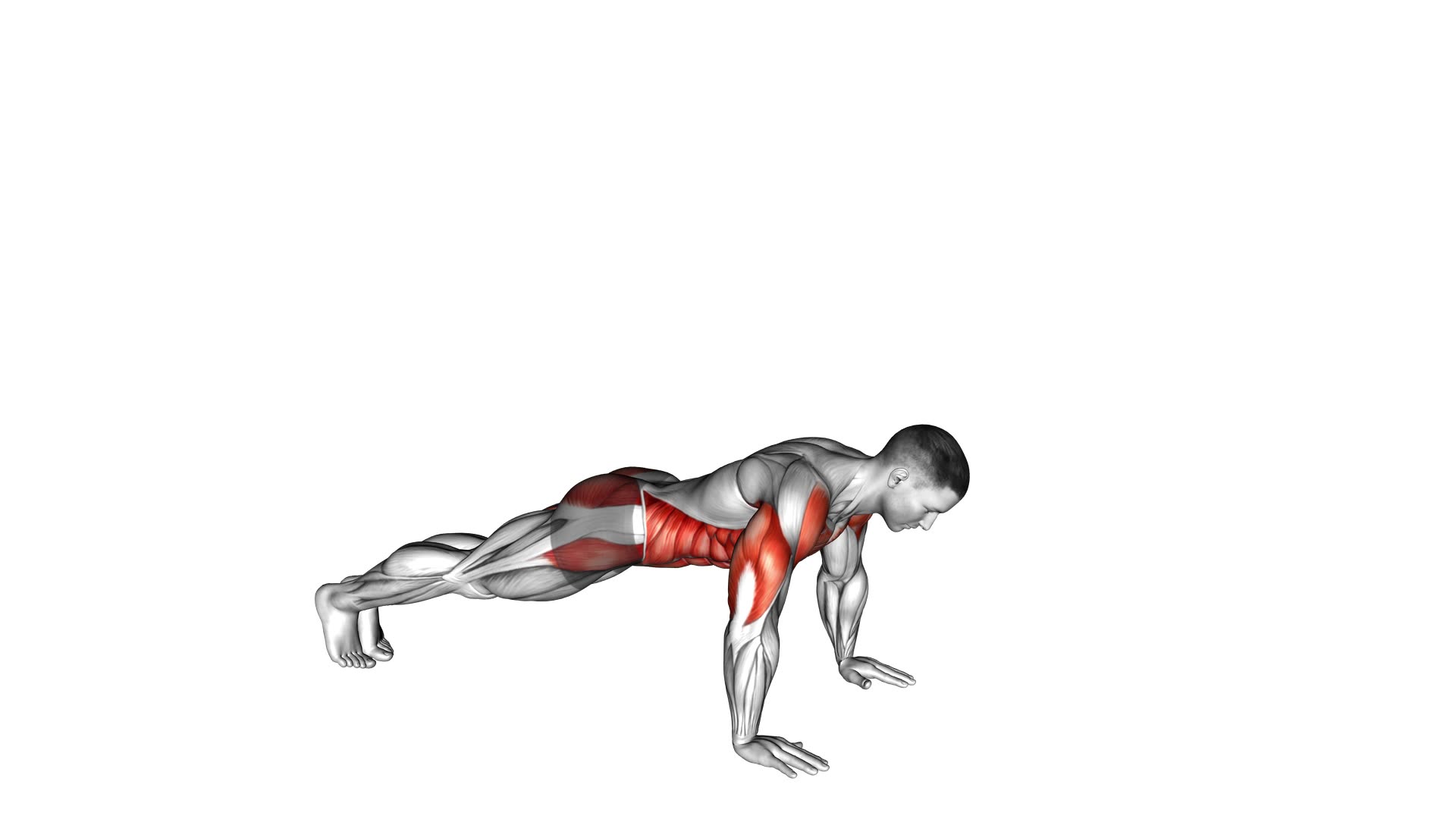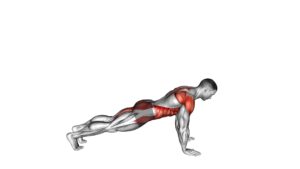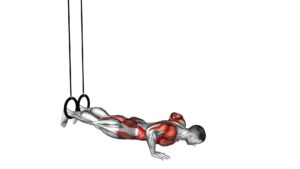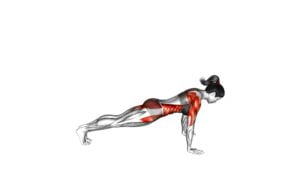Push-up to Side Plank – Video Exercise Guide & Tips

Get ready to take your workout to the next level with the push-up to side plank! This challenging exercise targets your chest, shoulders, core, and obliques all in one powerful move.
Watch This Exercise Video
In this video exercise guide, we'll show you the proper form, variations for all fitness levels, and tips for avoiding common mistakes.
Plus, we'll give you tips on how to increase the difficulty and incorporate this exercise into your workout routine.
Let's get started!
Key Takeaways
- The push-up to side plank targets multiple muscle groups including the chest, shoulders, core, and obliques.
- Engaging the core muscles during the exercise improves stability, posture, and reduces the risk of injury.
- Proper hand placement during the push-up is important for maintaining stability and preventing strain on the wrists.
- There are variations and modifications available for all fitness levels, allowing for gradual progression and adaptation to individual needs and limitations.
Benefits of the Push-up to Side Plank
You will experience numerous benefits from incorporating the push-up to side plank exercise into your fitness routine. This exercise, which involves transitioning from a push-up position to a side plank, offers a challenging yet effective method of strengthening your upper body and core muscles.
One of the key benefits of the push-up to side plank exercise is its ability to target and strengthen your core muscles. As you transition from the push-up position to the side plank, your obliques, transverse abdominis, and rectus abdominis muscles are engaged to stabilize your body. This helps to improve your overall core strength and stability, which is essential for maintaining proper posture and preventing injuries.
Additionally, the push-up to side plank exercise is an excellent way to enhance your upper body strength. The movement engages your chest, shoulders, triceps, and back muscles, leading to improved muscular endurance and strength in these areas. This exercise can also help to improve your shoulder stability and enhance your overall upper body control and coordination.
Incorporating the push-up to side plank exercise into your fitness routine can also contribute to improved overall body stability and balance. The movement requires you to engage multiple muscle groups simultaneously, which helps to improve your overall body awareness and coordination.
Proper Form for the Push-up to Side Plank
To perform the push-up to side plank with proper form, start by placing your hands slightly wider than shoulder-width apart. This hand placement will allow for better stability and engagement of the chest, triceps, and shoulders during the push-up movement.
Additionally, make sure to engage your core muscles throughout the exercise to maintain a straight line from your head to your heels.
Hand Placement During Push-Up
Achieve proper form for the push-up to side plank by ensuring precise hand placement. Hand position and wrist alignment are crucial for maximizing the effectiveness of this exercise.
Start by placing your hands shoulder-width apart on the ground, directly under your shoulders. Spread your fingers wide, with your middle fingers pointing forward. This will create a stable base of support for your upper body.
As you lower yourself down into the push-up, keep your wrists in line with your hands, avoiding any excessive bending or collapsing. This will help maintain proper alignment and prevent strain on your wrists.
Engaging Core Muscles
To engage your core muscles properly during the push-up to side plank exercise, maintain a strong and stable core throughout the movement.
Engaging your core muscles has several benefits, including improving your overall stability, enhancing your posture, and reducing the risk of injury during physical activities. By incorporating core strengthening exercises into your routine, you can increase your core strength and endurance, leading to better performance in other exercises and daily activities.
Some effective core strengthening exercises include planks, Russian twists, bicycle crunches, and dead bugs. These exercises target the muscles in your abdomen, back, and pelvis, helping to improve your balance and stability.
With a strong core, you'll be better equipped to perform the push-up to side plank exercise correctly and efficiently.
Now, let's explore variations and modifications for all fitness levels.
Variations and Modifications for All Fitness Levels
Let's explore the different variations and modifications available for individuals of all fitness levels when performing the push-up to side plank exercise.
For beginners, there are modifications that can help build strength and improve form, such as performing the exercise on your knees or using an elevated surface.
Advanced variations, on the other hand, can challenge those with higher fitness levels by adding complexity and intensity to the movement.
It's important to keep safety considerations in mind when selecting which modifications or variations to incorporate into your workout routine.
Beginner Modifications
For beginners, there are multiple modifications available to adapt the Push-up to Side Plank exercise to your fitness level. Here are some beginner modifications for modifying the side plank:
- Knee Modification: Start by kneeling on the ground instead of being in a full plank position. This reduces the intensity and allows you to focus on correct form.
- Hand-Elevated Modification: Place your hands on an elevated surface, such as a bench or step, to decrease the amount of bodyweight you have to lift.
- Forearm Modification: Instead of being on your hands, perform the exercise on your forearms. This provides more stability and is easier for beginners.
- Bent Knee Modification: Bend your knees and keep your feet on the ground during the side plank. This modification reduces the amount of weight on your core.
- Wall Modification: Perform the exercise against a wall, leaning against it for support. This helps beginners build strength and stability.
By incorporating these modifications, beginners can gradually progress and build strength in their core and upper body.
Now, let's explore some advanced variations of the Push-up to Side Plank exercise.
Advanced Variations
If you're looking to challenge yourself and take your Push-up to Side Plank exercise to the next level, here is an advanced variation that will engage your core and upper body even more.
To perform the advanced modification, start in a high plank position with your hands directly under your shoulders and your body in a straight line. Lower yourself into a push-up, keeping your elbows close to your body.
As you push back up, rotate your body to the side and extend one arm towards the ceiling, coming into a side plank position. Hold for a few seconds, then return to the starting position and repeat on the other side.
This advanced variation adds an extra challenge to your core stability and shoulder strength, making it a great choice for those looking for advanced core exercises.
Safety Considerations for Modifications
Ensure proper form and avoid injury by considering modifications and variations suitable for all fitness levels. When performing the push-up to side plank exercise, it's important to prioritize safety and make adjustments as needed. Here are some modifications and tips to keep in mind:
- Modifications for injuries: If you have wrist or shoulder pain, you can perform the exercise on your fists or use push-up handles to reduce strain. For knee discomfort, try performing the push-up portion on your knees or against a wall.
- Proper warm-up techniques: Before attempting the push-up to side plank, it's crucial to warm up your muscles and increase blood flow. Incorporate dynamic stretches and movements like arm circles, shoulder rolls, and leg swings to prepare your body for the exercise.
- Listen to your body: If you experience any pain or discomfort during the exercise, modify the movement or stop altogether. It's crucial to prioritize your safety and avoid pushing through pain.
- Consult a professional: If you have any pre-existing conditions or concerns, it's recommended to consult with a fitness professional or healthcare provider to ensure you're performing the exercise correctly and safely.
- Progress gradually: Start with easier modifications and gradually progress to more challenging variations as your strength and stability improve. This will help prevent injuries and allow your body to adapt to the exercise properly.
Common Mistakes to Avoid
To achieve proper form and maximize the effectiveness of the push-up to side plank exercise, it's crucial that you avoid these common mistakes.
First, don't let your hips sag or hike up during the push-up or side plank. This is a common mistake that can put unnecessary strain on your lower back and compromise the stability of the exercise. Remember to engage your core muscles and keep your body in a straight line from head to toe.
Another common mistake is rushing through the exercise without maintaining proper alignment. Make sure your hands are directly under your shoulders and your feet are stacked on top of each other during the side plank. Additionally, keep your elbows slightly bent and avoid locking them out during the push-up.
It is also important to avoid excessive shoulder rotation during the side plank. Keep your shoulders stacked on top of each other and avoid rolling or twisting them forward or backward. This will help maintain stability and prevent strain on the shoulder joint.
Lastly, don't forget to breathe throughout the exercise. Holding your breath can decrease your performance and make the exercise more challenging. Remember to inhale as you lower your body and exhale as you push back up or transition into the side plank.
Tips for Increasing the Difficulty of the Exercise
Challenge yourself by stepping up the intensity of the push-up to side plank exercise. If you're looking to take your workout to the next level, here are some advanced techniques to help you increase the difficulty of this exercise:
- Elevated Feet: Place your feet on an elevated surface, such as a bench or step, to increase the load on your upper body and core.
- Weighted Vest: Wear a weighted vest to add extra resistance and challenge your muscles even more.
- Single-leg Variation: Lift one leg off the ground while performing the exercise to engage your core and improve balance.
- Plyometric Push-ups: Incorporate explosive movements by pushing yourself up with enough force to lift your hands off the ground. This will increase power and strength.
- Staggered Arm Position: Instead of placing your hands directly under your shoulders, stagger them by moving one hand forward and the other hand back. This will challenge your stability and engage different muscle groups.
By incorporating these advanced techniques, you can increase the intensity of the push-up to side plank exercise and continue to challenge yourself as you progress.
Now, let's explore how you can incorporate this exercise into your workout routine.
Incorporating the Push-Up to Side Plank Into Your Workout Routine
To incorporate the push-up to side plank exercise into your workout routine, start by finding a comfortable and open space. This exercise is a combination of two movements: the push-up and the side plank. It targets multiple muscle groups, including the chest, shoulders, triceps, obliques, and core.
Before you begin, make sure you have mastered the basic push-up and side plank positions. Once you're comfortable with these exercises, you can progress to the push-up to side plank.
To perform the push-up to side plank, start in a push-up position with your hands slightly wider than shoulder-width apart. Lower your body down into a push-up, keeping your elbows close to your sides. As you push back up, shift your weight onto your left hand and rotate your body to the left, lifting your right arm up towards the ceiling. Hold the side plank position for a few seconds, then return to the starting position and repeat on the other side.
To increase the difficulty of this exercise, you can try different side plank progressions and push-up variations. For example, you can perform the push-up on an unstable surface, such as a stability ball, or elevate your feet on a bench during the push-up. These variations will challenge your stability and engage your muscles even more.
Incorporating the push-up to side plank into your workout routine is a great way to add variety and challenge to your upper body and core workouts. Start with a few sets of 8-10 repetitions on each side and gradually increase the number of sets and repetitions as you get stronger. Remember to maintain proper form throughout the exercise to maximize its benefits and prevent injury.
Frequently Asked Questions
How Many Calories Does the Push-Up to Side Plank Exercise Burn?
The push-up to side plank exercise is a great way to burn calories and strengthen your upper body. It engages multiple muscle groups, including your chest, shoulders, and core. By combining the push-up and side plank, you increase the intensity of the exercise, leading to a higher calorie burn.
However, it's important to be cautious if you have a shoulder injury, as this exercise puts stress on the shoulders. Always listen to your body and modify the exercise if needed.
Can the Push-Up to Side Plank Exercise Help in Reducing Belly Fat?
The push-up to side plank exercise is a great way to target your core and reduce belly fat. By combining a push-up with a side plank, you engage multiple muscle groups, including your abs, obliques, and arms.
This exercise helps to strengthen and tone your core while burning calories. By incorporating this exercise into your routine, you can work towards reducing belly fat and improving your overall core strength.
Is It Safe to Do the Push-Up to Side Plank Exercise if I Have a Shoulder Injury?
If you have a shoulder injury, it's important to modify the push-up to side plank exercise to avoid further damage.
There are alternative exercises that can be done instead, which will still work your core and upper body without putting strain on your injured shoulder.
It's always best to consult with a healthcare professional or a certified trainer who can guide you in choosing the right modifications and alternative exercises for your specific shoulder injury.
Can the Push-Up to Side Plank Exercise Help in Improving Posture?
Yes, the push-up to side plank exercise can help improve posture.
By engaging your core muscles, it strengthens the muscles in your back, shoulders, and abdomen, which are essential for maintaining proper posture.
This exercise also helps improve balance as you transition between the push-up and side plank positions.
How Long Should I Hold the Side Plank Position During the Exercise?
When doing the push-up to side plank exercise, it's important to hold the side plank position for an appropriate amount of time. The duration of the hold will depend on your fitness level and goals.
Holding the side plank for at least 10-30 seconds can help improve core strength and stability. However, you can increase the challenge by holding it for longer or trying variations of side plank exercises.
Remember to listen to your body and adjust accordingly.
Conclusion
The push-up to side plank is a challenging exercise that offers numerous benefits, including improved core strength, shoulder stability, and overall body control.
By following proper form and avoiding common mistakes, you can maximize the effectiveness of this exercise.
Additionally, by incorporating variations and modifications, you can tailor the push-up to side plank to suit your fitness level.
Whether you're a beginner or advanced, this exercise is a great addition to any workout routine.

Author
Years ago, the spark of my life’s passion ignited in my mind the moment I stepped into the local gym for the first time. The inaugural bead of perspiration, the initial endeavor, the very first surge of endorphins, and a sense of pride that washed over me post-workout marked the beginning of my deep-seated interest in strength sports, fitness, and sports nutrition. This very curiosity blossomed rapidly into a profound fascination, propelling me to earn a Master’s degree in Physical Education from the Academy of Physical Education in Krakow, followed by a Sports Manager diploma from the Jagiellonian University. My journey of growth led me to gain more specialized qualifications, such as being a certified personal trainer with a focus on sports dietetics, a lifeguard, and an instructor for wellness and corrective gymnastics. Theoretical knowledge paired seamlessly with practical experience, reinforcing my belief that the transformation of individuals under my guidance was also a reflection of my personal growth. This belief holds true even today. Each day, I strive to push the boundaries and explore new realms. These realms gently elevate me to greater heights. The unique combination of passion for my field and the continuous quest for growth fuels my drive to break new ground.







